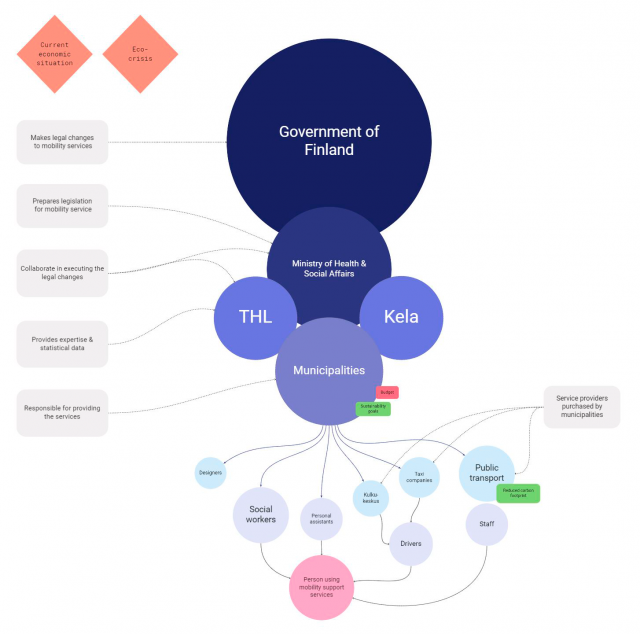This blog post reports on work-in-progress within the DfG course! The post are written by the group dealing with the brief on ‘Pilot project for Personal Budgeting Model’, provided by the Ministry of Social Affairs, Finnish Institute for Health and Welfare (THL), and the Social Insurance Institution of Finland (Kela) in collaboration with the ORSI project.
—
Group 1C: Eve Nieminen and Diana Becares Mas from the Creative Sustainability program, Esko-Matti Helin from Collaborative and Industrial Design program, and Faye from Human Computer Interaction Design program.
After the first weeks of the course, our group-work has consisted mainly of booking and carrying out interviews with as many stakeholders as possible. The approach the group has aimed for is qualitative, described by Jackson et al. (2007) as “the focus turns to understanding human beings’ richly textured experiences and reflections about those experiences” (p.22). In contrast, quantitative research would be “relying on a set of finite questions to elicit categorized, forced-choice responses with little room for open-ended replies to questions” (p.23).
It hasn’t been easy to figure out the relations and influences inside the system we have been working in. Therefore, after and based on the interviews and research, we created a system map. In it, we situated the stakeholders – the Ministry of Social Affairs and Health, Kela, THL, the municipalities, the different transport services (public transport and taxis) and the disabled people and their assistants – considering the influence they have on each other and in the whole of the system.

Observations within the gathered data
Being able to talk directly with people that take part in this system has brought light to our previous confusion. It has helped our group comprehend how the current mobility services are perceived; from both the providers’ perspective (social workers and municipalities) and the users’.
When analysing information, insights allow us to understand how things work from different perspectives. Some of the key insights we gathered relate to a need for clearer communication. During the interviews, our group noticed a lack of information on users’ rights and some differences in how disabled people understood the mobility services and how social workers spoke about them. For example, some users insisted on being well informed about the mobility pilot taking place but then said things that didn’t match the social workers’ answers. Another diverse range of opinions arose when discussing the level of quality that the mobility services should aim for, which also differed for the users and the municipalities.
Presenting our work in progress
Mid-term presentations were held last Monday, 29th. It was great to hear the stakeholders agreeing with our points of view on the lack of communication: how they’re interested in improving it and worried about the user’s experience. It was also beneficial to learn, for example, that our focus on Kulkukeskus was not essential for our project, so now we can deviate our attention from it. The ‘lack of personalization’ in the mobility/disability services was emphasized many times in the interviews, and again in the feedback session after presenting. Mainly, the idea that different people have very different needs and that there isn’t one perfect solution to fit everyone’s needs.
Re-visiting the initial brief, our group decided it could be a good idea to design our service paths also to clarify and communicate to the users what the services offer and how to take the most advantage of them.
These following weeks will be all about designing and visualizing the service paths out of all this valuable information we have gathered, however, our group is planning on enjoying this short Easter break to come back to work with a refreshed mind!
References:
Jackson II, Ronald L., Drummond, Darlene K. and Camara, Sakile (2007) ‘What Is QualitativeResearch?’, Qualitative Research Reports in Communication, 8: 1, 21 — 28
—
The DfG course runs for 14 weeks each spring – the 2021 course has now started and runs from 01 Mar to 24 May. It’s an advanced studio course in which students work in multidisciplinary teams to address project briefs commissioned by governmental ministries in Finland. The course proceeds through the spring as a series of teaching modules in which various research and design methods are applied to address the project briefs. Blog posts are written by student groups, in which they share news, experiences and insights from within the course activities and their project development. More information here about the DfG 2021 project briefs. Hold the date for the public online finale online 09:00-12:00 AM (EEST) on Monday 24 May!
